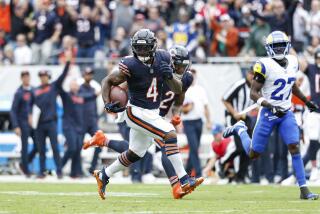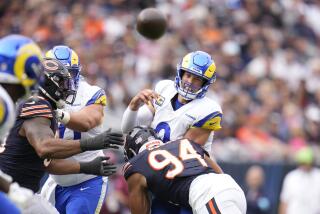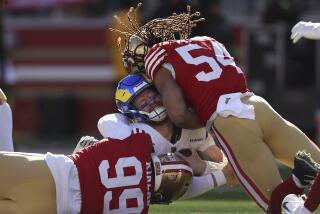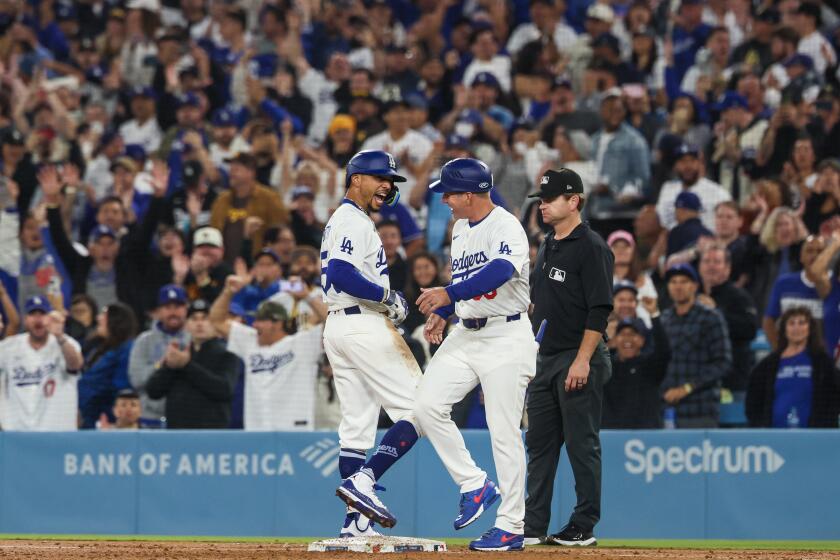73-0 : Halas Had His Monsters of the Midway Psyched Up for 1940 Rout of Redskins
As somebody once said, figures don’t lie.
Or do they? When the Chicago Bears met the host Washington Redskins for the National Football League championship 50 years ago last Saturday, each team had 17 first downs.
The Bears won in the most devastating rout in NFL history, 73-0.
When the Bears returned to the scene of the crime last Sunday, they made more first downs, 18 to the Redskins’ 15, than they had in the monumental mismatch of 1940. They also intercepted five passes, within three of their record total in the ’40 game. With all that going for them, they failed to muster a touchdown and lost, 10-9, on a late field goal set up by a fumble.
To be sure, there were figures in both games that reflected the outcomes. In 1940, the Bears gained 502 yards to the Redskins’ 245. Sunday, the teams had 288 yards apiece.
Last Sunday’s game at RFK Stadium was more like a rerun of a regular-season meeting between these old rivals at Griffith Stadium three weeks before the big one in 1940. The Redskins won that game, 7-3, when a potential touchdown pass from Sid Luckman to Bill Osmanski on the final play misfired and George Halas, the Bears’ owner-coach, yelped in vain for an interference call on the Redskins’ Frank Filchock.
Halas’ insistence that the Bears had been robbed set the stage for the Dec. 8 game. Halas and George Preston Marshall, owner of the Redskins, were friends and innovators in the NFL’s early days, but they also were archrivals. When Marshall heard about Halas’ lament, he said: “The Bears are front-runners, quitters. They’re a bunch of crybabies. They fold up when the going gets tough.”
These insults gave the Bears all the inspiration they needed. Halas made sure his players read them, and once they did, there was no holding them back.
The Bears arrived in Washington by train the day before the championship game. They went immediately to the stadium, working out after the Redskins had finished their practice. Some of the Redskins stuck around to watch, and Andy Farkas, quoted in the book, “Championship,” by Jerry Izenberg, recalled what they saw:
“The Bears came out screaming. . . . They took off and ran the length of the field. Then they circled the goal posts and started back, and they were still screaming.”
As soon as Halas saw this display, he called off the workout. He turned to assistant coach Hunk Anderson and said: “My, but the boys are enthusiastic. Get ‘em back inside. I don’t want them to lose that kind of enthusiasm.”
So the Bears didn’t practice at all the day before the game, and considering that heavy snow in Chicago had curtailed their activity all week, this was a drastic departure from the norm.
Halas knew what he was doing. The Bears were so charged for revenge that they wouldn’t have had to put on their uniforms all week.
Luckman, the Bears’ fine quarterback, talked about their pregame mood in a 1980 interview with the Milwaukee Journal:
“On the train, there was none of the usual joking or card-playing. I don’t think I heard five words the whole trip. And Coach Halas did a sensational job of building us up emotionally.
“When we got to Washington, the papers were playing up those stories by Marshall about us being crybabies. Coach Halas had people working all night getting the stories blown up, so he could put them on a wall in the dressing room. He was a psychological genius.
“Before we took the field, he pointed to the clippings and said, ‘Gentlemen, this is what Mr. Marshall thinks of you. I know you are the greatest football team in America. I know it and you know it. I want you to prove that to Mr. Marshall, the Redskins and, above all, the nation.’
“After that, we let out a big war whoop and broke the door down getting to the field.”
Much had been made in the pregame hype about the passing duel between Luckman and Sammy Baugh, both of whom were inducted into the Pro Football Hall of Fame.
Luckman, though, threw only four passes, the Bears only 10 all told, compared to the Redskins’ 51, of which Baugh threw 16 before being inexplicably yanked at halftime. With a running game that produced 382 yards to the Redskins’ 22 and a defense that came up with eight interceptions, three for touchdowns, who needed to pass?
Also, the Bears had perfected the T-formation with a man in motion--Halas had installed it in 1939--and their foes, still using the single wing, had yet to adjust to it.
There had been glitches in this novel offense in the past, but on this day, the Bears ran it precisely as it was drawn in Halas’ playbook. By quarters, they scored 21, seven, 26 and 19 points.
“It was the start of a whole new football world,” Luckman said. “Now everybody uses the T, and it all dates back to that game.”
Afterward, Halas expressed no regrets about running up the score. He said, “If we could have made 100, we would have.”
Nor did Marshall have any complaints. He said, “This is professional football, and the only way to keep it honest is to score as often as you can.”
It was with this awesome performance that the Bears earned the famous nickname, Monsters of the Midway. They also won recognition as the greatest football team of all time, only to outdo themselves the following year with a juggernaut that was even greater.
Halas, who died in 1983 at 88, discussed the strategy he had devised to learn whether the Redskins would stick to the 5-3-3 defense that had helped them win the earlier game.
“We had a two-way game plan,” Halas said. “We were quite sure they wouldn’t change something that had worked so well, but just in case, we were prepared.
“We ran one play as a test, to see which defense they were using. George McAfee (another future member of the Hall of Fame) gained eight yards, but the important thing was that we had our answer. The Redskins were staying with the same defense. I jumped off the bench and yelled. I knew we had ‘em.”
On the next play, the slaughter began. With McAfee going in motion to the right, Osmanski took a pitchout, went to the left and ran 68 yards for a touchdown. He appeared to be cornered at Washington’s 35-yard line, but George Wilson took out two Redskins with a block so spectacular that it is still featured in highlight footage of the game.
The Bears went on to roll up 11 touchdowns, with Harry Clark the only man to score twice. Typical of their depth, seven players attempted conversion kicks, and five succeeded at least once.
In those days, extra points and field goals were kicked into the stands, not into a net, and by the time the Bears had scored nine touchdowns, there was only one football left. So referee Red Friesell implemented an emergency plan.
When Solly Sherman knelt to hold for the kick after touchdown No. 10, Friesell asked: “What are you doing?”
Sherman said: “We’re kicking.”
Friesell said: “Oh no, you’re not. You’re passing. That’s the last ball we’ve got.”
So Sherman passed, for one point, and Bob Snyder did likewise after touchdown No. 11--but misfired.
There was one time early in the game when the Redskins made a move. After Osmanski’s opening touchdown, Max Krause returned the kickoff 56 yards, and the Redskins drove to the Bear 28. Baugh passed to Charlie Malone on the four, only to have him drop the ball. Bob Masterson then missed a field-goal attempt.
When the carnage had ended, Osmanski walked off the field with Baugh and tried to console him by saying: “Think what might have happened if Malone had caught that pass. It might have made a big difference.”
The distraught Baugh said: “Yeah, the score would have been 73-7.”
More to Read
Go beyond the scoreboard
Get the latest on L.A.'s teams in the daily Sports Report newsletter.
You may occasionally receive promotional content from the Los Angeles Times.









